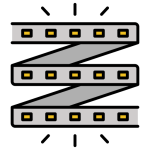The Ultimate LED Strip Lighting Guide: Ideas and Installation Tips


LED strip lighting has become a popular choice for those looking to enhance their space with customizable, energy-efficient lighting. From adding ambiance to transforming functional spaces, LED strip lights are versatile, affordable, and surprisingly easy to install. In this guide, we’ll walk you through the essentials of LED strip lighting—from innovative ideas for using LED strips in your home to step-by-step installation tips.
What Are LED Strip Lights?
LED strip lights are flexible circuit boards embedded with LEDs (light-emitting diodes) that can be cut to fit various spaces and installed almost anywhere. Available in a range of colors and brightness levels, LED strip lights offer endless possibilities for lighting design. Plus, they’re energy-efficient and long-lasting, making them a fantastic option for modern homes and businesses alike.

Benefits of LED Strip Lights
Before diving into creative ideas and installation tips, read why LED strip lighting is worth considering in our “LED Strip Lighting Guide”
- Energy Efficiency: LEDs consume less power, helping to reduce your energy bills.
- Customizability: Choose from various colors, brightness levels, and even waterproof options.
- Ease of Installation: Peel-and-stick adhesive backing makes installation quick and simple.
- Flexibility: Cut the strips to length and shape them to fit any surface.
- Long-Lasting: LED strips can last up to 50,000 hours, reducing replacement costs.
LED Strip Lighting Ideas for Your Home
Looking for inspiration? Here are some creative ideas to transform your space with LED strip lights:
1. Under-Cabinet Lighting in the Kitchen

Create a warm, inviting atmosphere with LED strips under your kitchen cabinets. They provide functional light for cooking while adding a modern touch to your kitchen decor.
2. Accent Lighting for Ceilings and Walls

Use LED strips to outline ceilings or walls, creating a soft, indirect glow that makes any room feel more spacious and elegant. This is especially popular for living rooms and bedrooms.
3. Illuminate Shelves and Display Cabinets

Highlight bookshelves, display cabinets, or floating shelves with LED strips. The light adds depth and helps to showcase decor items like artwork, plants, or books.
4. Home Theater Ambiance

Elevate your home theater experience with LED strip lighting behind your TV or around the perimeter of the room. It reduces eye strain and adds a cinematic touch.
5. Bathroom Mirror Backlighting

LED strips around bathroom mirrors provide excellent lighting for grooming and makeup, while also adding a spa-like feel to your bathroom.
6. Outdoor Deck and Pathway Lighting

Waterproof LED strips are great for illuminating outdoor decks, steps, and pathways. They enhance safety and add a beautiful, ambient glow to your outdoor space.
7. Headboard or Bed Frame Lighting

For a unique bedroom look, place LED strips around your headboard or under the bed frame. It creates a soft, calming glow, perfect for relaxing evenings.
Choosing the Right LED Strip Lights
To get the most out of your LED strip lights, it’s essential to choose the right type. Here’s what to consider:
- Brightness (Lumens): Higher lumens mean brighter light. Choose lower lumens for ambient lighting and higher for task lighting.
- Color Temperature: LED strips come in warm, neutral, and cool tones. Warm (2700-3000K) is ideal for cozy areas, while cool (4000-5000K) is better for task lighting.
- Color Options: You can opt for single-color, RGB (color-changing), or RGBW (color-changing + white) LED strips based on your preference.
- Waterproof Rating (IP Rating): For outdoor or bathroom use, choose waterproof LED strips with an IP65 rating or higher.
- Power Supply: Check the voltage requirements (usually 12V or 24V) and select a power supply compatible with the strip length and wattage.
How to Install LED Strip Lights: Step-by-Step Guide
Measure and Plan
- Measure the area where you’ll install the LED strips to determine the required length. Plan the placement carefully to avoid any interruptions in lighting.
Clean the Surface
- Clean the surface where you’ll be placing the strip lights. A dust-free surface ensures better adhesive bonding and longevity.
Cut to Fit
- LED strips can be cut along marked lines (usually every few inches) to fit your space perfectly. Be sure to cut only on designated cut lines to avoid damaging the strip.
Connect to the Power Supply
- Attach the LED strip to the power supply, making sure the connectors match the voltage requirements. Some LED strips come with plug-and-play connectors, while others may require a bit of soldering.
Peel and Stick
- Peel off the adhesive backing and press the strip onto the surface. If extra support is needed, you can use mounting clips.
Step 6: Test the Lighting
- Plug in the strip and test the lighting to ensure everything is connected correctly. Adjust the brightness or colors to suit your preference.
Maintenance Tips for LED Strip Lights
To keep your LED strip lights in top condition:
- Avoid Excessive Heat: Although LEDs produce minimal heat, they can be damaged by high temperatures. Keep them away from heat sources.
- Use a Dimmer: A dimmer switch helps to extend the lifespan of LEDs by reducing their overall power consumption.
- Regular Cleaning: Dust and grime can accumulate on LED strips over time. Gently clean them with a soft cloth to maintain brightness.
Troubleshooting Common LED Strip Light Issues
Sometimes, LED strips can encounter issues. Here’s how to troubleshoot common problems:
- LEDs Not Lighting Up: Double-check all connections and ensure the power supply is compatible with the strip’s voltage.
- Sections Not Working: If a section isn’t lighting up, check the cut lines. If they’re damaged, that segment might be faulty.
- Dimming or Flickering: This can be due to an underpowered power supply. Make sure the power source is strong enough to support the entire strip.
Conclusion
LED strip lighting guide is a fantastic way to add ambiance, functionality, and style to any space. With the variety of colors, brightness levels, and waterproof options available, you can customize LED strips to suit your needs perfectly. From kitchens and bathrooms to outdoor patios, LED strips are versatile enough to enhance nearly every area of your home or office. Follow these installation tips, choose the right LED strips for your needs, and transform your space with stunning, efficient lighting.
If you’re ready to make the switch, visit Switchofy.com for high-quality LED strip lighting solutions and accessories!

 i-Touch WiFi Switch
i-Touch WiFi Switch Door Bells
Door Bells Musical
Musical Bird Chirp
Bird Chirp Aarti / Mantra
Aarti / Mantra Islamic
Islamic Wireless Bells
Wireless Bells Industrial Bells
Industrial Bells Gong Bell
Gong Bell Water Alarm Bell
Water Alarm Bell


 COB Lights
COB Lights Panel Lights
Panel Lights Strip Light
Strip Light LED Driver
LED Driver
 Solar Street Light
Solar Street Light Street Lights
Street Lights Flood Lights
Flood Lights Garden Light
Garden Light
 Spike Guard
Spike Guard Travel Adapter
Travel Adapter Surface Gang Box
Surface Gang Box
 Single Pole MCB
Single Pole MCB










